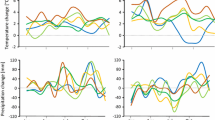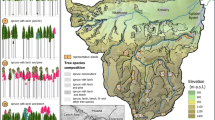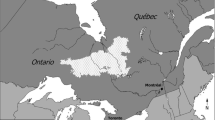Abstract
European forestry is facing many challenges, including the need to adapt to climate change and an unprecedented increase in forest damage. We investigated these challenges in a Norway spruce-dominated mountain region in Central Europe. We used the model Sibyla to explore forest biomass production to the year 2100 under climate change and under two alternative management systems: the currently applied management (CM), which strives to actively improve the forest’s adaptive capacity, and no management (NM) as a reference. Because biodiversity is thought to have mostly positive effects on the adaptive capacity of forests and on the quality of ecosystem services, we explored how climate change and management affect indicators of biodiversity. We found a differential response across the elevation-climatic gradient, including a drought-induced decrease in biomass production over large areas. With CM, the support of non-spruce species and the projected improvement of their growth increased tree species diversity. The promotion of species with higher survival rates led to a decrease in forest damage relative to both the present conditions and NM. NM preserved the high density of over-matured spruce trees, which caused forest damage to increase. An abundance of dead wood and large standing trees, which can increase biodiversity, increased with NM. Our results suggest that commercial spruce forests, which are not actively adapted to climate change, tend to preserve their monospecific composition at a cost of increased forest damage. The persisting high rates of damage along with the adverse effects of climate change make the prospects of such forests uncertain.




Similar content being viewed by others
References
Alessandri A, De Felice M, Zeng N, Mariotti A, Pan Y, Cherchi A, Lee JY, Wang B, Ha KJ, Ruti P, Artale V (2014) Robust assessment of the expansion and retreat of Mediterranean climate in the 21st century. Nat Sci Rep 4:7211. doi:10.1038/srep07211
Allen CD, Macalady AK, Chenchouni H, Bacheletd D, McDowelle N, Vennetierf M, Kitzbergerg T, Riglingh A, Breshearsi DD, Hoggj EH, Gonzalezk P, Fenshaml R, Zhangm Z, Castron J, Demidovao N, Limp JH, Allardq G, Runningr SW, Semercis A, Cobbt N (2010) A global overview of drought and heat-induced tree mortality reveals emerging climate change risks for forests. For Ecol Manag 259:660–684. doi:10.1016/j.foreco.2009.09.001
Anderegg WRL, Schwalm C, Biondi F, Camarero JJ, Koch G, Litvak M, Ogle K, Shaw JD, Shevliakova E, Williams AP, Wolf A, Ziaco E, Pacala S (2015) Pervasive drought legacies in forest ecosystems and their implications for carbon cycle models. Science 349(6247):528–532. doi:10.1126/science.aab1833
Badea O, Tanase M, Georgeta J, Anisoara L, Peiov A, Uhlirova H, Pajtik J, Wawrzoniak J, Shparyk Y (2004) Forest health status in the Carpathian Mountains over the period 1997–2001. Environ Pollut 130(1):93–98. doi:10.1016/j.envpol.2003.10.024
Bergh J, Linder S (1999) Effects of soil warming during spring on photosynthetic recovery in boreal Norway spruce stands. Glob Change Biol 5:245–253. doi:10.1046/j.1365-2486.1999.00205.x
Bigot C, Dorren LK, Berger F (2008) Quantifying the protective function of a forest against rockfall for past, present and future scenarios using two modelling approaches. Nat Hazards 49(1):99–111. doi:10.1007/s11069-008-9280-0
Boisvenue C, Running SW (2006) Impacts of climate change on natural forest productivity—evidence since the middle of the 20th century. Glob Change Biol 12:862–882. doi:10.1111/j.1365-2486.2006.01134.x
Bolte A, Ammer C, Löf M, Madsen P, Nabuurs GJ, Schall P, Spathelf P, Rock J (2009) Adaptive forest management in central Europe: climate change impacts, strategies and integrative concept. Scand J For Res 24:473–482. doi:10.1080/02827580903418224
Bošeľa M, Petráš R, Šebeňa V, Mecko J, Marušák R (2013) Evaluating competitive interactions between trees in mixed forests in the Western Carpathians: Comparison between long-term experiments and SIBYLA simulations. For Ecol Manag 310:577–588. doi:10.1016/j.foreco.2013.09.005
Briner S, Elkin C, Huber R, Grêt-Regamey A (2012) Assessing the impacts of economic and climate changes on land-use in mountain regions: a spatial dynamic modeling approach. Agric Ecosyst Environ 149:50–63. doi:10.1016/j.agee.2011.12.011
Briner S, Elkin C, Huber R (2013) Evaluating the relative impact of climate and economic changes on forest and agricultural ecosystem services in mountain regions. J Environ Manage 129:414–422. doi:10.1016/j.jenvman.2013.07.018
Bugmann H, Cordonnier T, Truhetz H, Lexer MJ (2015) Impacts of business as usual management on ecosystem services in European mountain ranges under climate change: Introduction. Reg Environ Change (accepted)
Cavin L, Mountford EP, Peterken GF, Jump AS (2013) Extreme drought alters competitive dominance within and between tree species in a mixed forest stand. Funct Ecol 27(6):1424–1435. doi:10.1111/1365-2435.12126
Dentener FJ (2006) Global maps of atmospheric nitrogen deposition, 1860, 1993, and 2050. Data set. Oak Ridge National Laboratory Distributed Active Archive Center, Oak Ridge, TN. daac.ornl.gov
Díaz S, Fargione J, Chapin FS III, Tilman D (2006) Biodiversity loss threatens human well-being. PLoS Biol 4(8):e277. doi:10.1371/journal.pbio.0040277
Ďurský J (1997) Modellierung der Absterbeprozesse in Rein und Mischbeständen aus Fichte und Buche. Allg Forst Jagdztg 168:131–134
Ďurský J, Pretzsch H, Kahn M (1996) Modellhalfe Nachbildung der Mortalität von Fichte und Buche in Einzelbaumsimulatoren. Jahrestagung 1996 der Sektion Ertragskunde des DVFFA in Neresheim, Tagungsber, pp 267–277
Elkin C, Gutiérrez AG, Leuzinger S (2013) A 2 °C warmer world is not safe for ecosystem services in the European Alps. Glob Change Biol 19:1827–1840. doi:10.1111/gcb.12156
Fabrika M, Ďurský J (2005) Algorithms and software solution of thinning models for SIBYLA growth simulator. J For Sci 51:431–445
Gamfeldt L, Snäll T, Bagchi R, Jonsson M, Gustafsson L, Kjellander P, Ruiz-Jaen MC, Fröberg M, Stendahl J, Philipson CD, Mikusiński G, Andersson E, Westerlund B, Andrén H, Moberg F, Moen J, Bengtsson J (2013) Higher levels of multiple ecosystem services are found in forests with more tree species. Nat Commun 4:1340–1347. doi:10.1038/ncomms2328
Griess VC, Acevedo R, Härtl F, Staupendahl K, Knoke T (2012) Does mixing tree species enhance stand resistance against natural hazards? A case study for spruce. For Ecol Manag 267:284–296. doi:10.1016/j.foreco.2011.11.035
Guariguata MR, Locatelli B, Haupt F (2012) Adapting tropical production forests to global climate change: risk perceptions and actions. Int For Rev 14:27–38. doi:10.1505/146554812799973226
Gustafsson L, Baker SC, Bauhus J, Beese WJ, Brodie A, Kouki J, Lindenmayer DB, Lõhmus A, Pastur GM, Messier C, Neyland M, Palik B, Sverdrup-Thygeson A, Volney WJA, Wayne A, Franklin JF (2012) Retention forestry to maintain multifunctional forests: a world perspective. Bioscience 62:633–645. doi:10.1525/bio.2012.62.7.6
Hanewinkel M, Cullmann DA, Schelhaas MJ, Nabuurs GJ, Zimmermann NE (2012) Climate change may cause severe loss in the economic value of European forest land. Nat Clim Change 3:203–207. doi:10.1038/nclimate1687
Harrison PA, Berry PM, Simpson G, Haslett JR, Blicharska M, Bucur M, Dunford R, Egoh B, Garcia-Llorente M, Geamănă N, Geertsema W, Lommelen E, Meiresonne L, Turkelboom F (2014) Linkages between biodiversity attributes and ecosystem services: a systematic review. Ecosyst Serv 9:191–203. doi:10.1016/j.ecoser.2014.05.006
Hlásny T, Sitková Z (2010) Spruce forests decline in the Beskids. National Forest Centre—Forest Research Institute Zvolen, Czech University of Life Sciences Prague, Forestry and Game Management Research Institute Jíloviště—Strnady, Zvolen, Slovakia
Hlásny T, Turčáni M (2013) Persisting bark beetle outbreak indicates the unsustainability of secondary Norway spruce forests: case study from Central Europe. Ann For Sci 70(5):481–491. doi:10.1007/s13595-013-0279-7
Hlásny T, Barcza Z, Fabrika M, Balázs B, Churkina G, Pajtík J, Sedmák R, Turčáni M (2011) Climate change impacts on growth and carbon balance of forests in Central Europe. Clim Res 47:219–236. doi:10.3354/cr01024
Hlásny T, Barcza Z, Barka I, Merganičová K, Sedmák R, Kern A, Pajtík J, Balázs B, Fabrika M, Churkina G (2014a) Future carbon cycle in mountain spruce forests of Central Europe: modelling framework and ecological inferences. For Ecol Manag 328:55–68. doi:10.1016/j.foreco.2014.04.038
Hlásny T, Mátyás C, Seidl R, Kulla L, Merganičová K, Trombik J (2014b) Climate change increases the drought risk in Central European forests: what are the options for adaptation? Lesn Cas For J 60:5–18. doi:10.2478/forj-2014-0001
Hlásny T, Trombik J, Dobor L, Barcza Z, Barka I (2015) Future climate of the Carpathians: Climate change hot-spots and implications for ecosystems. Reg Environ Change. doi:10.1007/s10113-015-0890-2
Huang JG, Bergeron Y, Denneler B, Berningerc F, Tardifd J (2007) Response of forest trees to increased atmospheric CO2. Crit Rev Plant Sci 26(5–6):265–283. doi:10.1080/07352680701626978
Huber R, Briner S, Peringer A, Lauber S, Seidl R, Widmer A, Gillet F, Buttler A, Le Bao Q, Hirschi C (2013) Modeling social-ecological feedback effects in the implementation of payments for environmental services in pasture-woodlands. Ecol Soc 18(2):41. doi:10.5751/ES-05487-180241
Jarvis P, Linder S (2000) Botany: constraints to growth of boreal forests. Nature 405:904–905. doi:10.1038/35016154
Jost L (2006) Entropy and diversity. Oikos 113:363–374. doi:10.1111/j.2006.0030-1299.14714.x
Jump AS, Mátyás C, Peñuelas J (2009) The altitude-for-latitude disparity in the range retractions of woody species. Trends Ecol Evol 24:694–701. doi:10.1016/j.tree.2009.06.007
Kahn M (1994) Modellierung der Höhenentwicklung ausgewählter Baumarten in Abhängigkeit vom Standort. Forstliche Forschungsber, München
Klapwijk MJ, Csóka G, Hirka A, Björkman C (2013) Forest insects and climate change: long-term trends in herbivore damage. Ecol Evol 3:4183–4196. doi:10.1002/ece3.717
Körner C, Ohsawa M (2005) Mountain systems. In: Hassan R, Scholes R, Ash N (ed) Millennium Ecosystem Assessment. Current state and trends: findings of the condition and trends working group. Ecosystems and human well-being, vol 1. Island Press, Washington, DC, pp 681–716
Larrieu L, Cabanettes A (2012) Species, live status, and diameter are important tree features for diversity and abundance of tree microhabitats in subnatural montane beech–fir forests. Can J For Res 42:1433–1445. doi:10.1139/x2012-077
Lassauce A, Paillet Y, Jactel H, Bouget C (2011) Deadwood as a surrogate for forest biodiversity: meta-analysis of correlations between deadwood volume and species richness of saproxylic organisms. Ecol Indic 11:1027–1039. doi:10.1016/j.ecolind.2011.02.004
Linderholm HW, Linderholm K (2004) Age-dependent climate sensitivity of Pinus sylvestris L. in the central Scandinavian Mountains. Boreal Environ Res 9:307–317
Lindner M, Maroschek M, Netherer S, Kremer A, Barbati A, Garcia-Gonzalo J, Seidl R, Delzon S, Corona P, Kolström M, Lexer MJ, Marchetti M (2010) Climate change im-pacts, adaptive capacity, and vulnerability of European forest ecosystems. For Ecol Manag 259:698–709. doi:10.1016/j.foreco.2009.09.023
Lindner M, Fitzgerald JM, Zimmermann NE, Reyer C, Delzon S, van der Maaten E, Schelhaas MJ, Lasch P, Eggers J, van der Maaten-Theunissen M, Suckow F, Psomas A, Poulter B, Hanewinkel M (2014) Climate change and European forests: what do we know, what are the uncertainties, and what are the implications for forest management? J Environ Manage 146:69–83. doi:10.1016/j.jenvman.2014.07.030
Mamet SD, Kershaw GP (2013) Age-dependency, climate, and environmental controls of recent tree growth trends at subarctic and alpine treelines. Dendrochronologia 31(2):75–87. doi:10.1016/j.dendro.2012.08.002
Martin GL, Ek AR, Monserud RA (1977) Control of plot edge bias in forest stand growth simulation models. Can J For Res 3(1):100–105. doi:10.1139/x77-014
Marušák R, Kašpar J (2015) Spatially-constrained harvest scheduling with respect to environmental requirements and silvicultural system. Lesn Cas For J 61(2):71–77
Matala J, Hynynen J, Miina J, Ojansuu R, Peltola H, Sievänen R, Väisänen H, Kellomäki S (2003) Comparison of a physiological model and a statistical model for prediction of growth and yield in boreal forests. Ecol Model 161(1):95–116. doi:10.1016/S0304-3800(02)00297-1
Mátyás C, Berki I, Czúcz B, Gálos B (2010) Future of beech in Southeast Europe from the perspective of evolutionary ecology. Acta Zool Hung 6:91–110
Mendes C, Américo MS, Štefanek B, Feliciano D, Mizaraite D, Nonic D, Kitchoukov E, Nybakk E, Duduman G, Weiss G, Nichiforel L, Stoyanova M, Mäkinen P, Alves R, Milijic V, Sarvašová Z (2011) Institutional innovation in European private forestry: the emergence of forest owners’ organizations. In: Weiss G (ed) Innovation in forestry: territorial and value chain relationships. CABI Publishing, Wallingford, pp 68–86
Mette T, Dolos K, Meinardus C, Bräuning A, Reineking B, Blaschke M, Pretzsch H, Beierkuhnlein C, Gohlke A, Wellstein C (2013) Climatic turning point for beech and oak under climate change in Central Europe. Ecosphere 4(12):145. doi:10.1890/ES13-00115.1
Millington JDA, Walters MB, Matonis MS, Liu J (2011) Modelling for forest management synergies and trade-offs: northern hardwood tree regeneration, timber and deer. Ecol Model 248:103–112. doi:10.1016/j.ecolmodel.2012.09.019
Moravčík M, Čaboun V, Priwitzer T (2010) Slovak Republic. In: Tommpo E et al (ed) National Forest Inventories: Pathways for common reporting. Springer, Netherlands, pp 489–504
Morin X, Fahse L, de Mazancourt C, Scherer-Lorenzen M, Bugmann H (2014) Temporal stability in forest productivity increases with tree diversity due to asynchrony in species dynamics. Ecol Lett. doi:10.1111/ele.12357
Nakicenovic N, Swart R (eds) (2000) Special report on emission scenarios. Cambridge University Press, Cambridge
Neuner S, Albrecht A, Cullmann D, Engels F, Griess VC, Hahn WA, Hanewinkel M, Härtl F, Kölling C, Staupendahl K, Knoke T (2014) Survival of Norway spruce remains higher in mixed stands under a dryer and warmer climate. Glob Change Biol. doi:10.1111/gcb.12751
Paluch R, Jastrzebski J (2013) Natural regeneration of shade-tolerant Abies alba Mill. in gradients of stand species compositions: limitation by seed availability or safe microsites? For Ecol Manage 307:322–332. doi:10.1016/j.foreco.2013.06.035
Paquette A, Messier C (2011) The effect of biodiversity on tree productivity: from temperate to boreal forests. Glob Ecol Biogeogr 20(1):170–180. doi:10.1111/j.1466-8238.2010.00592.x
Pedro MS, Rammer W, Seidl R (2014) Tree species diversity mitigates disturbance impacts on the forest carbon cycle. Oecologia. doi:10.1007/s00442-014-3150-0
Peñuelas J, Ogaya R, Boada M, Jump SA (2007) Migration, invasion and decline: changes in recruitment and forest structure in a warming-linked shift of European beech forest in Catalonia (NE Spain). Ecography 30(6):829–837. doi:10.1111/j.2007.0906-7590.05247.x
Pretzsch H, Kahn M (1998) Konzeption und Konstruktion des Wuchsmodells SILVA 2.2—Methodische Grundlagen. Abschlußbericht Projekt W 28, Teil 2, München
Pretzsch H, Biber P, Ďurský J (2002) The single tree-based stand simulator SILVA: construction, application and evaluation. For Ecol Manage 162:3–21. doi:10.1016/S0378-1127(02)00047-6
Pretzsch H, Biber P, Schutze G, Bielak K (2014) Changes of forest stand dynamics in Europe. Facts from long-term observational plots and their relevance for forest ecology and management. For Ecol Manag 316:65–77. doi:10.1016/j.foreco.2013.07.050
Puettmann KJ, Wilson SM, Baker SC (2015) Silvicultural alternatives to conventional even-aged forest management—what limits global adoption? For Ecosyst 2:8. doi:10.1186/s40663-015-0031-x
Rebetez M, Dobbertin M (2004) Climate change may already threaten Scots pine stands in the Swiss Alps. Theor Appl Climatol 79(1–2):1–9. doi:10.1007/s00704-004-0058-3
Schlyter P, Stjernquist I, Bärring L, Jönsson AM, Nilsson C (2006) Assessment of the impacts of climate change and weather extremes on boreal forests in northern Europe, focusing on Norway spruce. Clim Res 31:75–84. doi:10.3354/cr031075
Schmid S, Zingg A, Biber P, Bugmann H (2005) Evaluation of the forest growth model SILVA along an elevational gradient in Switzerland. Eur J For Res 125(1):43–55. doi:10.1007/s10342-005-0076-4
Seidl R, Schelhaas MJ, Lindner M, Lexer MJ (2008) Modelling bark beetle disturbances in a large scale forest scenario model to assess climate change impacts and evaluate adaptive management strategies. Reg Environ Change 9(2):101–119. doi:10.1007/s10113-008-0068-2
Seidl R, Schelhaas MJ, Rammer W, Verkerk PJ (2014) Increasing forest disturbances in Europe and their impact on carbon storage. Nat Clim Change 4:806–810. doi:10.1038/nclimate2318
Simoncic T, Boncina A, Rosset C, Binder F, De Meo I, Cavlovic J, Gal J, Matijasic D, Schneider J, Singer F, Sitko R (2013) Importance of priority areas for multi-objective forest planning: a Central European perspective. Intl For Rev 15(4):509–523. doi:10.1505/146554813809025685
Spiecker H, Hansen J, Klimo E, Skovsgaard JP, Sterba H, von Teuffel K (2004) Norway spruce conversion—options and consequences. Brill, Leiden
Staudhammer CL, LeMay VM (2001) Introduction and evaluation of possible indices of stand structural diversity. Can J For Res 31(7):1105–1115. doi:10.1139/x01-033
Tatarinov F, Cienciala E, Vopěnka P, Avilov V (2011) Effect of climate change and nitrogen deposition on central-European forests: regional-scale simulation for South Bohemia. For Ecol Manage 262(10):1919–1927. doi:10.1016/j.foreco.2011.02.020
Temperli C, Bugmann H, Elkin C (2013) Cross-scale interactions among bark beetles, climate change, and wind disturbances : a landscape modeling approach. Ecol Monogr 83(3):383–402. doi:10.1890/12-1503.1
Thom D, Seidl R, Steyrer G, Krehan H, Formayer H (2013) Slow and fast drivers of the natural disturbance regime in Central European forest ecosystems. For Ecol Manag 307:293–302. doi:10.1016/j.foreco.2013.07.017
Thuiller W, Lavorel S, Araújo MB, Sykes MT, Prentice IC (2005) Climate change threats to plant diversity in Europe. Proc Natl Acad Sci USA 102:8245
Thuiller W, Richardson DM, Midgley GF (2007) Will climate change promote alien plant invasions? In: Nentwig W (ed) Biological invasions. Ecological studies. Springer, Berlin, vol 193, pp 197–211
Uhde B, Andreas Hahn W, Griess VC, Knoke T (2015) Hybrid MCDA methods to integrate multiple ecosystem services in forest management planning: a critical review. Environ Manage. doi:10.1007/s00267-015-0503-3
van der Linden P, Mitchell JFB (ed) (2009) ENSEMBLES: climate change and its impacts: summary of research and results from the ENSEMBLES project. Met Office Hadley Centre, FitzRoy Road, Exeter EX1 3PB, UK
Walther GR, Post E, Convey P, Menzel A, Menzel A, Parmesan C, Beebee TJC, Fromentin JM, Hoegh-Guldberg O, Bairlein F (2002) Ecological responses to recent climate change. Nature 416:389–395. doi:10.1038/416389a
Wang WJ, He SH, Spetich MA, Shifley SR, Thompson FR, Dijak WD, Wang Q (2014) A framework for evaluating forest landscape model predictions using empirical data and knowledge. Environ Model Softw 62:230–239. doi:10.1016/j.envsoft.2014.09.003
Way DA (2011) The bigger they are, the harder they fall: CO2 concentration and tree size affect drought tolerance. Tree Physiol 31(2):115–166. doi:10.1093/treephys/tpr009
Wichmann L, Ravn HP (2001) The spread of Ips typographus (L.) (Coleoptera, Scolytidae) attacks following heavy windthrow in Denmark, analysed using GIS. For Ecol Manag 148:31–39. doi:10.1016/S0378-1127(00)00477-1
Zlatanov T, Elkin C, Irauschek F, Lexer MJ (2015) Impact of climate change on vulnerability of forests and ecosystem service supply in Western Rhodopes Mountains. Reg Environ Change. doi:10.1007/s10113-015-0869-z
Acknowledgments
This research was funded by the EC 7FP project ARANGE (FP7-289437-ARANGE) (35 %), projects ITMS 26220120069 (20 %) and ITMS 26220220066 (20 %) supported by the Operational Programme Research and Development funded by the European Regional Development Fund, projects supported by the Slovak Research and Development Agency under contracts nos. DO7RP-0030-11 (5 %) and APVV-0111-10 (10 %), and projects QJ 1220316 (5 %) and QJ 1220317 (5 %) supported by the National Agency for Agriculture Research of the Czech Republic. We thank to prof. Bruce Jaffee (USA) for linguistic and editorial improvement.
Author information
Authors and Affiliations
Corresponding author
Electronic supplementary material
Below is the link to the electronic supplementary material.
Rights and permissions
About this article
Cite this article
Hlásny, T., Barka, I., Kulla, L. et al. Sustainable forest management in a mountain region in the Central Western Carpathians, northeastern Slovakia: the role of climate change. Reg Environ Change 17, 65–77 (2017). https://doi.org/10.1007/s10113-015-0894-y
Received:
Accepted:
Published:
Issue Date:
DOI: https://doi.org/10.1007/s10113-015-0894-y




